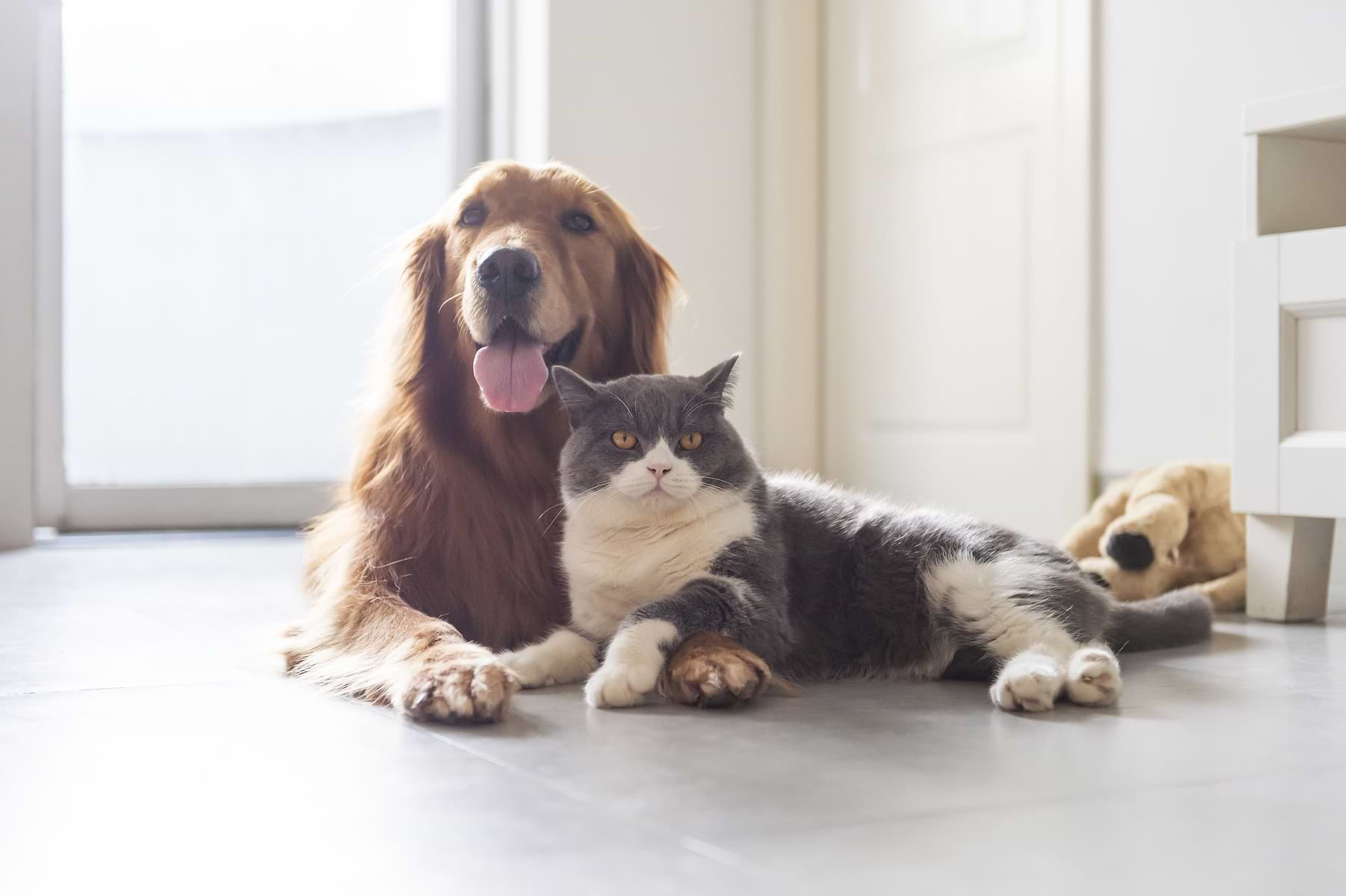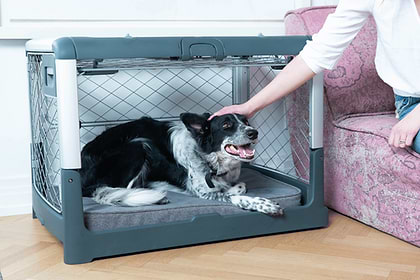Okay, so you’re welcoming a new cat into your home, but you already have a dog. What to do? Will this work? Or is this a disaster waiting to happen? Absolutely not! Let’s consider all of the ways you can make both of your furry friends feel comfortable, safe, and taken care of. Here are 9 tips and tricks on how to introduce your dog to a cat, or vice versa. With the right tools in your toolbox, you can make this a painless process. The bonus is you’ll be left with two happy pets.
Is It a Good Idea?
No matter what cartoons say, there are many instances of dogs and cats getting along just fine. That being said, it’s all about the introduction. Of course, the earlier the better in getting your pets acclimated to one another but ultimately, time and patience are going to win them over and seal the deal.
Now, there are no guarantees as their coexistence will depend on breed types, personalities, timing, and the circumstances at play. For example, greyhounds and terriers may have more trouble cohabitating with cats because of their strong prey drive. But the bottom line is that cats and dogs can peacefully coexist if they are given the appropriate amount of time to get to know each other and if the introductions are done right.
Tips and Tricks for Introduction
There are a variety of steps you can take to begin the process of introducing your dog to a new cat. Read onwards.
1. Slow and Steady Wins the Race
Ease into it. No, seriously. This should be a very gradual process. Rushing through introductions can cause fear and aggression on both ends. Proceed cautiously. Slow and steady desensitization is a good starting point. Desensitization is the process of exposing your pet to a subject that would normally cause a grandiose (and undesirable) reaction in small increments until there is little to no response. Ultimately, we want your canine companion to be unphased by the cat’s presence.
During desensitization, start with separation and a barricade, like a gate or other type of blockage. Let the two look at each other and self-evaluate the situation. Try teaching your dog that while it’s okay to look at the cat and wonder, it’s also good to focus elsewhere (like on a toy or a basic command). Praise your dog for being able to divert their focus. Hyper-fixation is not good.
Over time, increase your dog’s exposure to the cat. Start with a few minutes and gradually make your way to a few hours. This should be over the course of days or even weeks, depending on your pets’ progress.
2. Use the Crate
At the start of introductions, use your dog’s comfortable crate as a default. Ideally, your pup is crate trained before the introductions occur. The crate should be your dog’s safe haven. It should be a snug place that they go to feel protected and secure. Make sure you situate your dog’s crate away from your cat’s space, including their feeding area, the place they sleep, and where they go to the bathroom.
How to make it snug? Fill it with an orthopedic pet pad and incorporate a crate training aid slathered with yummies. Meeting the new cat might be scary for your pup, and we want them to feel like they have a place to retreat if they’re feeling threatened or scared in any way, shape, or form.
You can also use the crate in your efforts to desensitize. In this case, you can try bringing your cat into the room while your dog is calm in their crate. Let the two get used to being in the same room together. No forced interactions! Rotate which animal has freedom and which animal is confined. The reason for this? It’ll give your pets their own time to warm up to each other. Let the animals do their own investigating. Allow your pup to roam, explore and smell, and do the same for your feline.
Once they both seem comfortable, you can abandon the confinement measure. Leash your pup at first until they are ready for the next step. More on face-to-face interactions below.
Similarly, giving your cat some safe spaces just for them like hiding places, tunnels, or a cat tree may help them feel safer in your home.
3. Supervision
The desensitization method should be kept supervised no matter what the circumstance. It’s important to keep your eye on the dog and cat while they are in the same room together, even if there is a barricade. In fact, all interactions should be supervised in the beginning. We want to avoid one of your pets getting hurt or having a panic attack.
All that being said, unsupervised time together is not only allowed, but it’s important. You should only take this step when you are certain that your pets are ready for it. This should be after no less than one month.
4. Separate When Feeding
It’s common for dogs and cats to snack from each other’s bowls when they live together. If you’re just starting out with introductions, make sure that you are feeding your two animals in separate places. Here are a couple of reasons why.
For one, dogs shouldn’t be eating cat food, and cats shouldn't be eating dog food. The two have very different nutritional needs. Eating each other’s food can lead to gastrointestinal distress, obesity, and kidney problems.
Secondly, having your cat near your dog’s food bowl can lead to possessive food guarding. It’s normal and instinctual but can leave one of your pets seriously injured. Resource guarding in dogs can range from relatively benign behavior, like running away, to something more serious like biting and charging. Your best bet is to keep your dog and your cat separate while feeding.
Similarly, your cat's litter tray should be kept far away from your pup, so they can use their litter box without interference.
5. Learn Body Language
It’s a good idea to do some research on dog body language before you bring a cat home, or before you bring a dog home to your cat. While dogs can’t talk in the way that humans can, they will certainly communicate with you through their body language.
Dogs communicate with their eyes, ears, tail, and hackles. They communicate audibly as well with barking, growls, whining, and yawning. If you notice your dog is super fixated on your cat, their hackles are raised and their tail is down, note this as your dog negatively responding to the cat’s presence. Positive dog body language includes a loose-wagging and spiked tail, a forward posture, and a submissive grin. A submissive grin paired with a loose, wiggly posture is code for “Nice to meet you!” This is a sign that things are on the ups.
6. Face-to-Face Sessions
Once one pet is desensitized to the other (best if it’s a mutual desensitization) and you have a handle on your dog’s body language, you can begin face-to-face sessions. These sessions can be a bit more fast-paced, and they can help to set boundaries for your pets. Better if there are two people involved so you have control over both animals if the situation goes haywire.
Use your dog’s leash loosely, but let your pup approach your cat, face-to-face. Keep an eye on their body language. If the cat is not raising his back or hissing around the dog, they can be allowed to move around freely. A cat is rarely a threat to a dog, but some cats will be on the offensive when meeting them.
Your dog is in a good place if they are able to listen to basic commands while the cat is roaming around. In other words, they shouldn’t be hyper-fixated. During face-to-face sessions, ask your pup to sit, stay, and lie down when the cat is in the room. Don’t forget to positively reinforce when your dog is able to ignore the cat’s presence. This is a great achievement and a sign that your dog is feeling comfortable around the cat.
7. Swap Scents
This is a great way to allow your pets to become accustomed to each other’s smells. Ideally, this takes place right before introductions occur. There are a couple of ways to do this. You can swap their sleeping blankets (avoid swapping their beds as this could lead to possessive guarding) or you can rub a towel on one pet and put the towel under the other pet’s feeding bowl. The goal is to surround your pets with each other’s smells until there is no reaction to them at all.
8. Repetition
Repetition is crucial here. Ultimately, we want your dog to get to a place where they are practically unphased by the cat. Allot multiple times throughout the day and week to desensitize. Allow for a handful of face-to-face sessions. Keep this on repeat until you’re seeing noticeable changes in the behavior of both your cat and your dog.
9. Positive Reinforcement
Using positive reinforcement is a great way to teach your dog the appropriate way to act around a cat. Make sure that you’re not just reprimanding your dog for doing wrong. Give your pup a reward (either a treat or verbal praise) for acting calmly around the cat and being able to obey basic commands while diverting their interest. If you are constantly punishing your dog while the cat is in their presence, it could have an adverse effect.
When To Seek a Specialist
It’s always a good idea to consult your vet before bringing a cat into your home that already houses a dog. If the introduction is not going how you planned, don’t force it. Talk to your dog trainer or your dog’s veterinarian. You don’t want to put either of your pets in harm’s way. Most importantly, don’t ever use punishment. Using punishment will not be effective and will do more damage than good.
If you’re noticing signs that your two animals are not getting along (especially after attempted desensitization and face-to-face sessions), you should consult a professional. No shame in hiring a handler to help make your pets feel more comfortable and to relieve your own pet parent anxieties. Training sessions can go a long way!
Continuous Growling and Hissing
Continuous growling from your dog and hissing from your cat, even after weeks and weeks of desensitization and face-to-face sessions, is not a great sign. This could mean that your two pets are not receptive to living together. If you find this to be the case, get your veterinary team involved.
Hyperfixation
If your dog is hyper-fixated on the cat even after repetition, consider this a warning sign. Hyper-fixation means that your dog is overly focused even when not provoked, ignores when you attempt to give them a command or distraction, or lunges towards the feline anytime they move. If you notice this kind of behavior, contact a handler.
Stops Eating
If your dog stops eating whenever the cat is near, this could be a sign of aggressive behavior. Keep your eye on the dog when your resident cat approaches their bowl. Does your pup stop and stare at the cat? Do they start growling toward the feline? Is your dog following the cat’s every move? Seek professional help if so.
Changes in Body Language
Pay close attention to your canine companion’s dog body language when your cat is around. Are they baring their teeth? Pinning their ears backwards? Assuming a biting posture? Are they glaring? Has their tail wagging slowed? These are all indications of prey drive and not a good position for your cat to be in. Talk to a professional if this is happening.
Summary
Let’s brush up on the 9 tips and tricks on how to introduce your dog to a cat. Slowly desensitizing your animals, using the crate as a tool, supervision during introductions and separating while feeding is a great place to start. Studying dog body language, incorporating face-to-face sessions, swapping scents, using positive reinforcement and repetition are great as well. Give these methods a try and go from there. Hopefully, you'll find that your pets exhibit calm behavior, so your new pet and your current pet can live in harmony.
Just remember to give your pets their own space, and let them go at their own pace. It may take more time for a shy cat or kittens to warm up to your existing pet, but good behavior is always possible.
As mentioned, be on the lookout for warning signs that your pets aren’t adapting and adjusting to the intros. Continuous growling and hissing, hyper-fixation and changes in body language are indicators that your pets aren’t fond of one another and could become aggressive. Take note of your dog’s changes in behavior, like if they stop eating when the cat is present, and proceed with caution.
The common expression, “They’re fighting like cats and dogs!” isn’t accurate. It has been proven time and time again that cats and dogs have the potential to get along just fine. In fact, there is little evidence to suggest that cats and dogs are natural-born enemies. It’s a myth! There are plenty of dog and cat BFFs out there, so don’t be afraid to introduce your resident pet to their new family member. Chances are, they’ll get along great!
Sources:
How to Introduce a Dog to a Cat | Best Friends Animal Society
How to Introduce a Dog and Cat | Animal Human Society
Overcoming Fears with Desensitization and Counterconditioning | VCA Animal Hospital
How Should I introduce My New Dog or Puppy to the Family Cat? | RSPCA Knowledgebase
Understanding Dog Body Language: Decipher Dogs' Signs & Signals | American Kennel Club

The Diggs Team
We believe our dogs deserve safer, better designed pet products.
You might also like
Crate training tips, stories and inspiration
View all blogsIn Your Diggs
Share your photos with #DiggsPet and tag us @DiggsPet on IG and TikTok.



